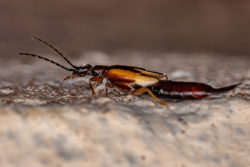Earwigs are insects that have two antennae, six legs, three body parts, and a powerful pair of pincers on the end of their abdomen. Depending on the species, they can be anywhere from 5 millimeters to 25 millimeters long. And while earwigs can be found in human ears, they do not nest in the ear canals, and contrary to popular belief, they do not eat human brains. It is generally agreed that earwigs pose no health risks to people. However, when they invade houses, gardens, and flower beds, they can be a major nuisance.
Earwigs have an appendage called cerci on the end of their abdomen, similar to pincers. They will sometimes use these pincers to attack or defend themselves against other insects and can also damage plants and flowers. While they can pinch humans, they will generally try to run away from them instead. Although their name suggests they can crawl in the ears of humans, this is an old wives tale. Earwigs aren’t poisonous and aren’t toxic or harmful to humans or pets.
Keep earwigs out of your home with these earwig prevention tips:
- Repair leaks, as they are attracted to moist habitats.
- Remove any leaves that may blow into basements and garages.
- Consider installing a vapor barrier in your crawlspace.
- Use a dehumidifier in your basement or crawlspace.
- Install tight-fitting door sweeps.
- Repair any foundation cracks on your home.
- Use tight-fitting window screens.
Although earwigs aren’t harmful to humans, they can be a nuisance to have around. Contact your local pest control company to help eliminate these and other common household pests.



